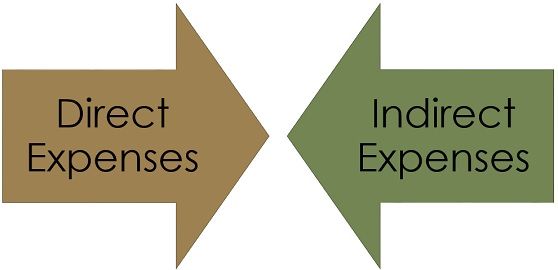

Expenses refer to the cost incurred on something and when it comes to business, the incurrence of expenses is a daily affair. These expenses may be related to production or regular business operations. When the expenses are linked to the production of a product, it is considered as a direct expense.
Direct expenses can be identified or associated with the specific cost object such as product or service. Here, the word cost object refers to any product, service, process, or job for which cost is ascertained. Further, there is one more category of expenses, i.e. indirect expenses, which is incurred in connection to regular business operations and so their traceability with respect to a specific cost object is difficult.
| Basis for Comparison | Direct Expenses | Indirect Expenses |
|---|---|---|
| Meaning | Any expenses other than direct material and direct wages, which are outrightly attributable to the product or service is called direct expenses. | Any expenses other than indirect material and indirect wages, which cannot be outrightly allocable to a specific cost centre, is called indirect expenses. |
| Incurrence | Production or purchase of goods | Office and Administration |
| Allocation or Apportionment | Directly allocated to the particular cost unit. | Directly apportioned on a suitable basis. |
| Cost of goods sold | It is included in the cost of goods sold. | It is not included in the cost of goods sold. |
| Appears in | Debit side of the trading account. | Debit side of profit and loss account. |
| Treatment | Forms part of prime cost. | Treated as overheads. |
Direct Expenses refers to the expenditure different from direct material cost and direct labour cost, which are spent on the production of product or provision of service. These expenses can be easily identified and chargeable to a cost unit, cost centre, job or cost object in an economically feasible way.
Direct expenses are chargeable expenses and so they are debited to Direct Expenses Account.
There is only a small portion of direct expenses in the total cost of goods. Further, these costs can be controlled by establishing standards, then comparing the same with the actual figures and analyzing the causes of variances and corrective measures are implemented.
Indirect Expenses covers all those expenses which are not included in direct material, direct wages and direct expenses. Basically, these are the costs which benefit the entire firm as a whole and not just one department or segment of the business. These expenses cannot be outrightly and completely allocated to the specific cost centre or cost unit. However, these can be apportioned to and absorbed by the cost centres, or cost unit.
Indirect Expenses which are related to the factory are allocated to the units of output produced in the factory in the period in which expenses were incurred.
Further, when the product to which it is attributed is sold, then it is a charge to expense. However, if the expenses are related to office and administration, they are allocated only when it is corporate overhead.
The differences between direct and indirect expenses are presented in the points given below:
Direct Expenses
Indirect Examples
By and large, Direct expenses include all those expenses, excluding direct material and direct labour cost, which are incurred specifically for a product. These expenses varies according to the volume of the output produced. It plays an important role in the calculation of gross profit.
On the other hand, indirect expenses are are the costs of running and maintaining business, which benefits multiple departments or units at a time and that is why they are shared by different products, segments or departments. Indirect expenses are debited in profit and loss account, to arrive at net profit.
Sir/ mam I really really really love your site you people have done a great job. You don’t know but all of your content helps a lot in my exams since 4 year…. I really like to thanks all of the one who work really hard behind this website❤
Thanks for giving me such valuable information that I don’t know, but after reading this article, I know the difference between direct expenses and indirect expenses.